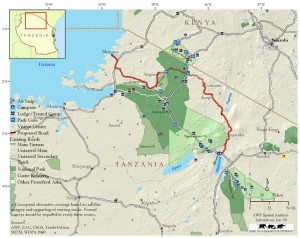A proposal by President Kikwete to build a road through the Serengeti National Park has created a storm of protest amongst wildlife supporters around the world.
So much so that the New York Times, which rarely features Tanzania, has devoted a leading article (August 30) to the subject under the heading: The Wrong Road (Thank you Peg Snyder for sending this – Editor).
Extracts: ‘In late July, President Kikwete announced that his government intended to go ahead in 2012 with plans to build a highway running from Arusha …..to Musoma. No one disputes the economic value of developing highways in Tanzania. But this planned highway includes a potentially tragic pitfall: it cuts straight through the heart of the northern Serengeti, one of the greatest national parks on the planet.
It would bisect the route of the great migration, the annual movement of more than a million wildebeest and other herds. President Kikwete has promised that this would only be a gravel road, and has said that he would never build anything that could harm the ecosystem.
But it would be a commercial highway nonetheless, and it would link two populous regions of Tanzania. Even a gravel road across the northern Serengeti would bring an immediate flood of traffic, instantly fragmenting the ecosystem and causing enormous potential for human-animal conflict in the form of accidents and poaching…
Tanzania could still protect the integrity of the park…. There is an alternative southern route, one that would link more unserved communities than the northern route and still leave the Serengeti intact.
What is …needed is international pressure on the governments and NGO’s that would normally help finance this kind of economic development. That includes China, which plays an enormous role in African development. This is not a choice between economic development and protecting the Serengeti. It is a choice between the wrong kind of development and the right kind.’
However, the alternative southern route would be significantly more expensive, particularly since few dispute that better roads from Arusha to Loliondo and Musoma to Mugumo are required.
The government is therefore left with a difficult decision on whether to complete the link with a road between Loliondo and Mugumo, or else pay for a completely new road to the south of the National Park, the route as yet unsurveyed, but perhaps via Bariadi. The former would represent around 130km of road, including 50km through the Serengeti, much of it on existing tracks, while the alternative southern route would entail over 500km of road, and would arguably not represent a significant enough improvement over the existing road link via Singida and Shinyanga to justify the enormous expense involved.
In early September President Kikwete, in a nationwide broadcast, indicated that he was unrepentant. He said the project was part of a policy to link all regions with permanent roads. He added however that, in view of the need to protect the environment, part of the road would not be macadamized. “I would like to assure our friends abroad that I am an ardent supporter of the Serengeti reserve so I will be the last person to supervise any environmental degradation” – Nipashe.


Pingback: Tanzanian Affairs » MISCELLANY
Pingback: Tanzanian Affairs » TOURISM & ENVIRONMENTAL CONSERVATION